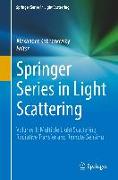- Start
- Springer Series in Light Scattering
Springer Series in Light Scattering
Angebote / Angebote:
Many natural and biological media vary randomly in time and space. The examples are terrestrial atmosphere and ocean, biological liquids and tissues to name but a few. The main purpose of Springer Series in Light Scattering is to present recent advances in studies of light propagation, scattering, emission and absorption in random media. The topic is very broad and incorporates such diverse areas as atmospheric optics, ocean optics, optics of close-packed media, radiative transfer, light scattering, absorption, and scattering by single scatterers as well as by systems of particles, biomedical optics, optical properties of cosmic dust, remote sensing of atmosphere and ocean, etc. This branch of optical physics is of importance for material science, environmental science, climate change, and also for optical engineering. Although main developments in the solutions of radiative transfer and random media optics problems have been achieved in the 20th century by efforts of many scientists including V. Ambartsumian, S. Chandrasekhar, P. Debye, H. C. van de Hulst, G. Mie, and V. Sobolev, the optics of random media still present many puzzles to be solved such as radiative transfer in closely packed media, 3D radiative transfer as applied to the solution of inverse problems, optics of terrestrial and planetary surfaces, etc. It also has a broad range of applications in many fields of modern science and technology such as biomedical optics, atmospheric and oceanic optics, and astrophysics. The Series raises novel scientific questions, integrates data analysis, and offers new insights in optics of light scattering media.
Folgt in ca. 15 Arbeitstagen
